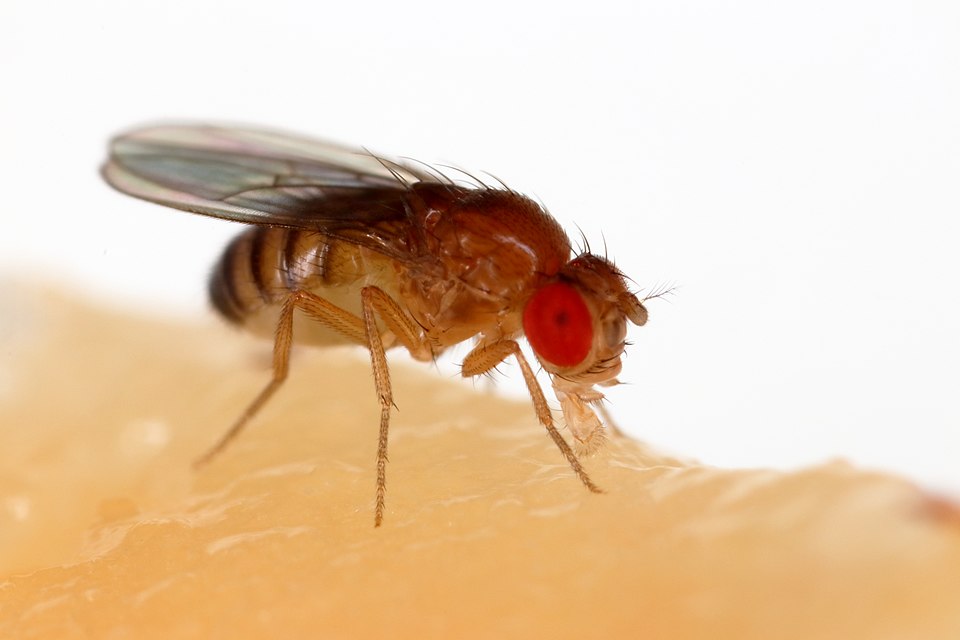On the fly
Looking back on it, Ph.D. student Ishani Ganguly’s interest in computational neuroscience seems foretold. “Dad is a computer scientist,” she says. “Mom is a biologist. I became basically a computational biologist.”
In her doctoral research at Columbia University, Ganguly creates models of the neuronal connections in the fruit fly brain that support learning. The work could also help researchers understand similar circuits and processes in humans and other complex organisms.
Her interest in fruit fly brains started during a summer undergraduate internship at the Howard Hughes Medical Institute’s Janelia Research Campus, where she enjoyed seeing direct connections between learning and neuroanatomy.
When she applied to Columbia’s Ph.D. program, one of her future advisors, Ashok Litwin-Kumar, introduced her to the FlyWire Consortium’s fruit fly connectome, brain-image slices that assemble the fly’s 30,000 or so neurons and the synapses that connect them. “The brain can be viewed as a connectivity matrix,” she explains, “but it can also be these incredibly detailed electron micrograph images, which are just beautiful to look at.”
The insect brain’s chief learning center is the mushroom body, named for its fungilike shape. Its circuitry resembles the cerebellum, a motor learning center in vertebrates. “If we can understand how the mushroom body learns, presumably we can understand more about learning in humans,” Ganguly says.
Supported by a Department of Energy Computational Science Graduate Fellowship, Ganguly has studied neurons that bridge between senses, allowing visual stimuli to put their stamp on olfactory memories. Humans reap the benefits of such learning when, for example, food aromas seem appealing when they come from a serving plate but less so when they waft from a dumpster. Such connections could help fruit flies synchronize foraging behavior with the time of day.
Ganguly followed the lead that 8 percent of mushroom body Kenyon cells, neurons that represent sensory information, receive input from the eyes instead of olfactory receptors. She wanted to know if fruit flies could remember good or bad odors — having a positive or negative valence — based on the visual context as well as the odor itself.
Using the connectome, she traced the connections to the vision-linked Kenyon cells, which had never been characterized before, and found that some inputs come from retinal receptors that detect ultraviolet light. In an ongoing collaboration with experimental neuroscientist Rudy Behnia, who coadvises her Ph.D., Ganguly helped design an experiment that validated the findings. Behnia’s experimentalists recorded responses to UV light in live fruit flies’ neurons. Some connections lead to neurons that set the brain’s circadian clock.
The researchers think these pathways may synchronize the fly’s behavior with the time of day, since UV light appears in specific proportions at dawn and dusk, the main foraging times for fruit flies. Ganguly was a first author on the team’s paper in Nature Communications.
Since then, Ganguly collaborated with Behnia’s group to set up an experiment to see if adding UV light would alter olfactory learning. Researchers had previously shown that, if a fruit fly is rewarded for approaching a particular odor, it will remember the odor and return to it in a later test. The Columbia team divided flies into groups and exposed each group to the same pairings of two odors, one at a time, with either UV light or darkness. Each group was rewarded for approaching a different odor-lighting combination. The team found that flies learn odors in a visual context-dependent manner. For example, if they were rewarded for choosing odor one under UV light, they continued to choose odor one over odor two — but only in the UV, not in the dark.
Ganguly then designed a multisensory model of the mushroom body that would learn through trial and error. She arranged nodes that mimic olfactory Kenyon cells to interact with nodes serving as visual Kenyon cells. Additional circuitry introduced reinforcement learning, delivering the dopamine-like rewards that trigger learning. At first, the model did not learn that the lighting provided context information for learning.
However, when Ganguly included an additional mushroom body cell, the anterior paired lateral (APL) neuron, the model performed more like a real fruit fly. “The primary hypothesis is that, when you get a visual input through the APL, it silences some olfactory neurons, and this changes the representation of the same smell in UV versus dark,” Ganguly says. Behnia’s lab is working to silence the APL in fruit flies to see how its loss affects multisensory learning.
In 2023, Ganguly’s practicum took her to Lawrence Berkeley National Laboratory, where she worked with Bert de Jong on trial-and-error machine-learning approaches to identify molecules for use in solar cells. She found that the reinforcement learning methods she uses in her mushroom body research could also deliver appropriate rewards to guide algorithms that design molecules that meet the specifications for such applications.
Ganguly plans to graduate in 2026 and hopes to expand her interest in learning and behavior toward computing “and look at how we can take these elements of biological learning and apply them to machine learning.”
About the Author
Andy Boyles is a senior science writer at the Krell Institute and contributing science editor at Highlights for Children Inc.






You must be logged in to post a comment.